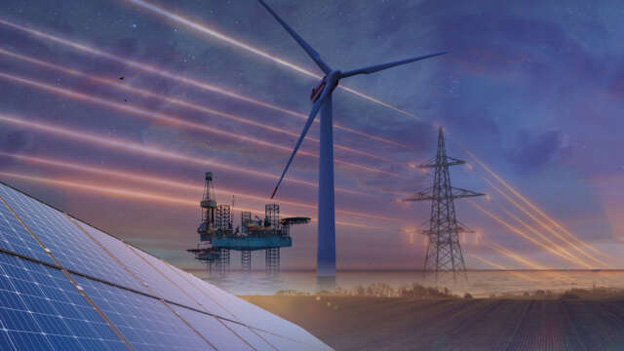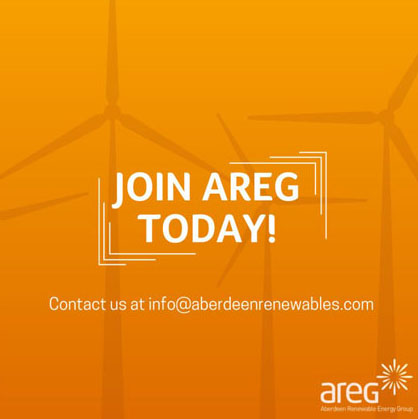
Established in 2003, Aberdeen Renewable Energy Group (AREG) is a not-for-profit organisation with a mission to help its members take advantage of renewable energy opportunities and champion the sector, accelerating our journey to net zero.
Support and Opportunities
AREG plays a key role in developing a sustainable renewable energy sector in Scotland and the UK through supporting our unrivalled membership network of energy professionals and attracting investment.
AREG aligns opportunities with capabilities in the supply chain, supports renewable energy businesses and facilitates the transfer of technology, skills and expertise from oil & gas. The organization promote the region and their members nationally and internationally, as well as enabling, supporting, and promoting local renewable projects.
A place to invest
AREG plays a key role in developing a sustainable renewable energy sector in Scotland and the UK through supporting our unrivalled membership network of energy professionals and attracting investment.
Renowned as a Global Energy Hub it is a vibrant, entrepreneurial region in Scotland’s North East, home to a unique mix of business opportunities and specialist skills across various sectors including energy, technology, life sciences and food & drink.
Renewable sectors:
Biomass Energy
Biomass power is electricity generated from organic materials, usually sourced from the forestry and agriculture sectors. Plants convert energy from the sun into organic material. This energy is then released when the organic material is burned. This energy-rich material is a renewable resource because the plants harvested in the process can be replanted for use in the future.
Key Facts
- In 2018, 637 TWh of electricity was generated from biomass globally
- Biomass can produce natural gases, such as methane, which can be used to power and heat homes
- With 740MW capacity, the Ironbridge power plant located in the Severn Gorge, UK, is the world’s biggest biomass power plant
- In 2020 the UK generated 26,845 gigawatts-per-hour (GWh) of electricity from plant biomass alone
- In 2018, almost 40% of energy consumption from renewable and waste sources came from biomass
Geothermal Energy and Heat Pumps
Geothermal energy is the energy stored below the surface of the Earth. The thermal energy is contained within the rock and fluids which can be found from shallow ground to several miles below the surface. In some countries, thermal energy has even been harvested from the magma chambers found below the Earth’s crust.
Key Facts
- The first geothermally generated electricity was produced in Larderello, Italy, in 1904
- Geothermal energy is generated in more than 25 countries
- In 2019 over 90,000 GWh of electricity was generated from geothermal energy
- The US is the world’s largest producer of geothermal energy
- The Geysers Geothermal Complex in California is the biggest geothermal development in the world
- In Iceland, a country with over 25 active volcanoes, many of the buildings and even swimming pools are heated with geothermal hot water
- Around 25% of Iceland’s electricity needs are generated from harnessing the Earth’s thermal energy
Hydrogen and Fuel Cells
Hydrogen is a very abundant element, which can be produced in an electrolyser using renewable electricity. This converts water into hydrogen and oxygen using the electricity, and the hydrogen gas can then be compressed stored in high pressure cylinders.
Key Facts
- Hydrogen can be used directly in fuel cells, as an alternative fuel in combustion devices such as engines and boilers, or as a chemical feedstock in a number of important industrial processes such as ammonia or methanol manufacture.
- Fuel Cells use an electrochemical process to convert chemical fuels into electricity. The fuel is combined with oxygen from the ambient air to produce electricity, with heat and water as the waste products.
- Unlike batteries, Fuel Cells will continue to generate electricity as long as a source of fuel is supplied.
- Fuel Cells do not combust fuel but use a catalytic oxidation which makes this electricity generation process quiet, pollution-free and more efficient than using internal combustion engine powered generators.
- Hydrogen and Fuel Cells are now playing a key role in developing low carbon smart energy systems with several projects underway in Scotland.
Onshore Wind Energy
Wind turbines harness the energy of moving air to rotate the blades and generate electricity. Onshore wind refers to the turbines found on land, while offshore turbines are located out at sea, such as the European Offshore Wind Deployment Centre (EOWDC).
Onshore wind is one of the cheapest forms of electricity generation. Onshore wind farms in excess of 50MW generation are classified as National Development.
Key Facts
- As of Q1 2023, Scotland has 9.3 GW of installed onshore wind capacity, enough to power the equivalent of over 5 million households.
- As of 2020, onshore wind generated the highest proportion of electricity in Scotland, 21,788 GWh.
- As of 2020, employment associated with onshore wind accounted for 10,115 jobs across Scotland.
- As of 2020, onshore wind had the largest economic output of renewable energy with a total of £2,439,000 to the economy.
Onshore Wind Energy
Wind turbines harness the energy of moving air to rotate the blades and generate electricity. Onshore wind refers to the turbines found on land, while offshore turbines are located out at sea, such as the European Offshore Wind Deployment Centre (EOWDC).
Onshore wind is one of the cheapest forms of electricity generation. Onshore wind farms in excess of 50MW generation are classified as National Development.
Key Facts
- As of Q1 2023, Scotland has 9.3 GW of installed onshore wind capacity, enough to power the equivalent of over 5 million households.
- As of 2020, onshore wind generated the highest proportion of electricity in Scotland, 21,788 GWh.
- As of 2020, employment associated with onshore wind accounted for 10,115 jobs across Scotland.
- As of 2020, onshore wind had the largest economic output of renewable energy with a total of £2,439,000 to the economy.
Solar, Thermal and PV
Our sun is a nuclear reactor which emits energy in the form of photons to our planet every day. We call this Solar Energy. There are various ways that Solar Energy can be harnessed but the two main ways within the UK are via Solar Photovoltaic (PV) Panels and Solar Thermal Panels.
Key Facts
- Solar PV systems use direct and indirect (diffuse) light to convert solar energy into usable electricity.
- Solar Thermal uses solar energy to heat water / glycol via flat plate collectors or evacuated tube collectors.
- The electricity or heat created is low carbon and fast becoming the most cost-effective form of creating energy
- In 2020 the UK generated over 13,000 GWh of electricity from solar photovoltaics
- China produces by far the most solar energy in the world, measured at 205 GW in 2019, according to the IEA’s Renewables 2020 report
Wave Energy
Ocean waves are generated by the action of winds on the surface of the world’s oceans and both this generation mechanism and the ability of water waves to propagate over large distances make ocean wave energy one of the most concentrated sources of renewable energy available.
Key Facts
- Attempts to develop devices capable of extracting energy from ocean waves have been made since at least the late 18th century.
- The world’s first wave power plant was opened in 2008 at Portugal’s Agucadoura Wave Farm.
- It is estimated that up to 21.5GW of wave and tidal energy could be generated from the waters around Scotland annually.
- Scotland produces about 10% of the total wave energy of Europe thus making it a significant player in the wave energy market and a centre of Research and Development.
- The Orkney Islands in Scotland are one of the leading areas in wave energy in the world.
If you are interested in finding out more about becoming an AREG member, contact our team to arrange an introductory meeting.
KeyFacts Energy Industry Directory: AREG
 KEYFACT Energy
KEYFACT Energy
